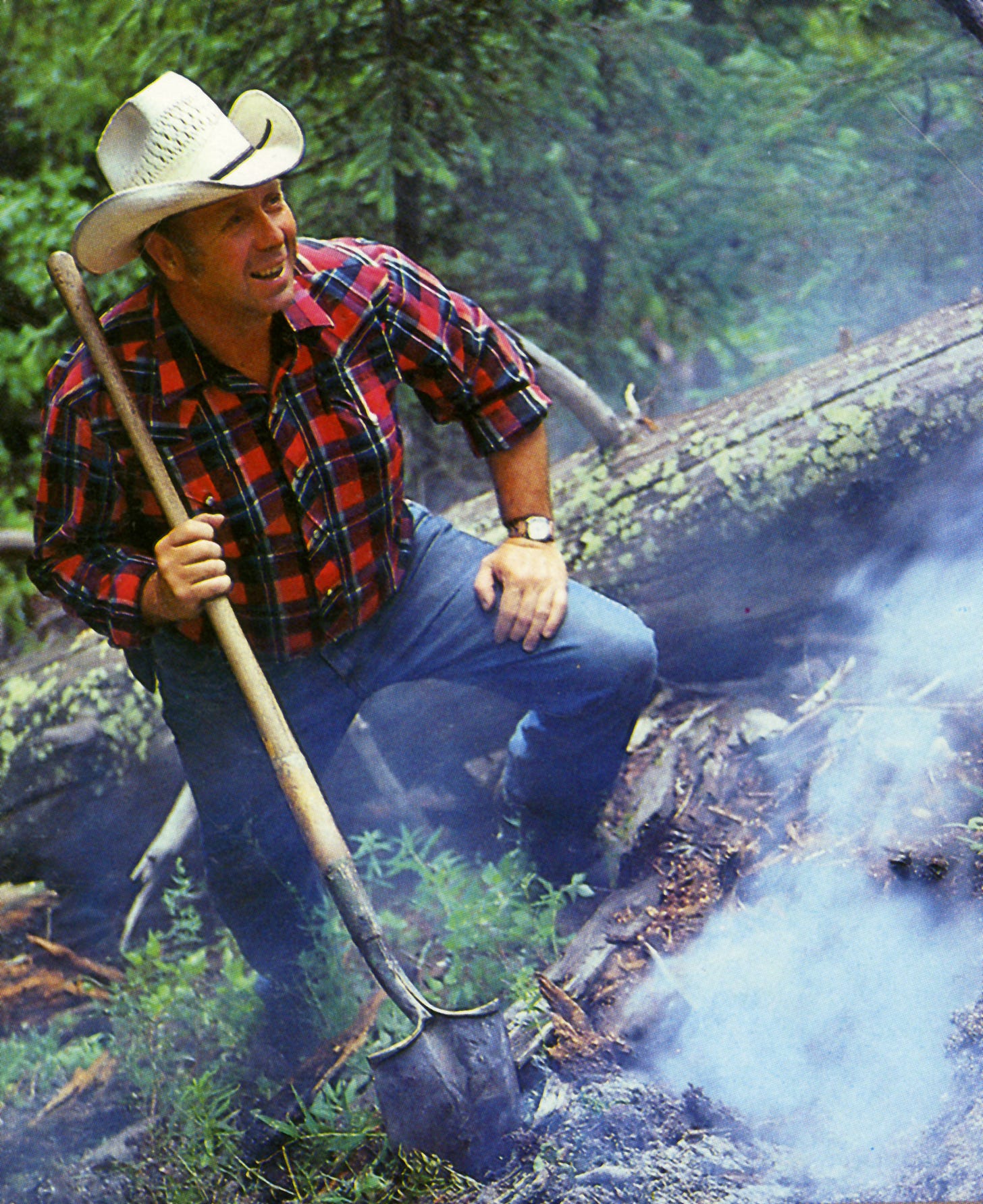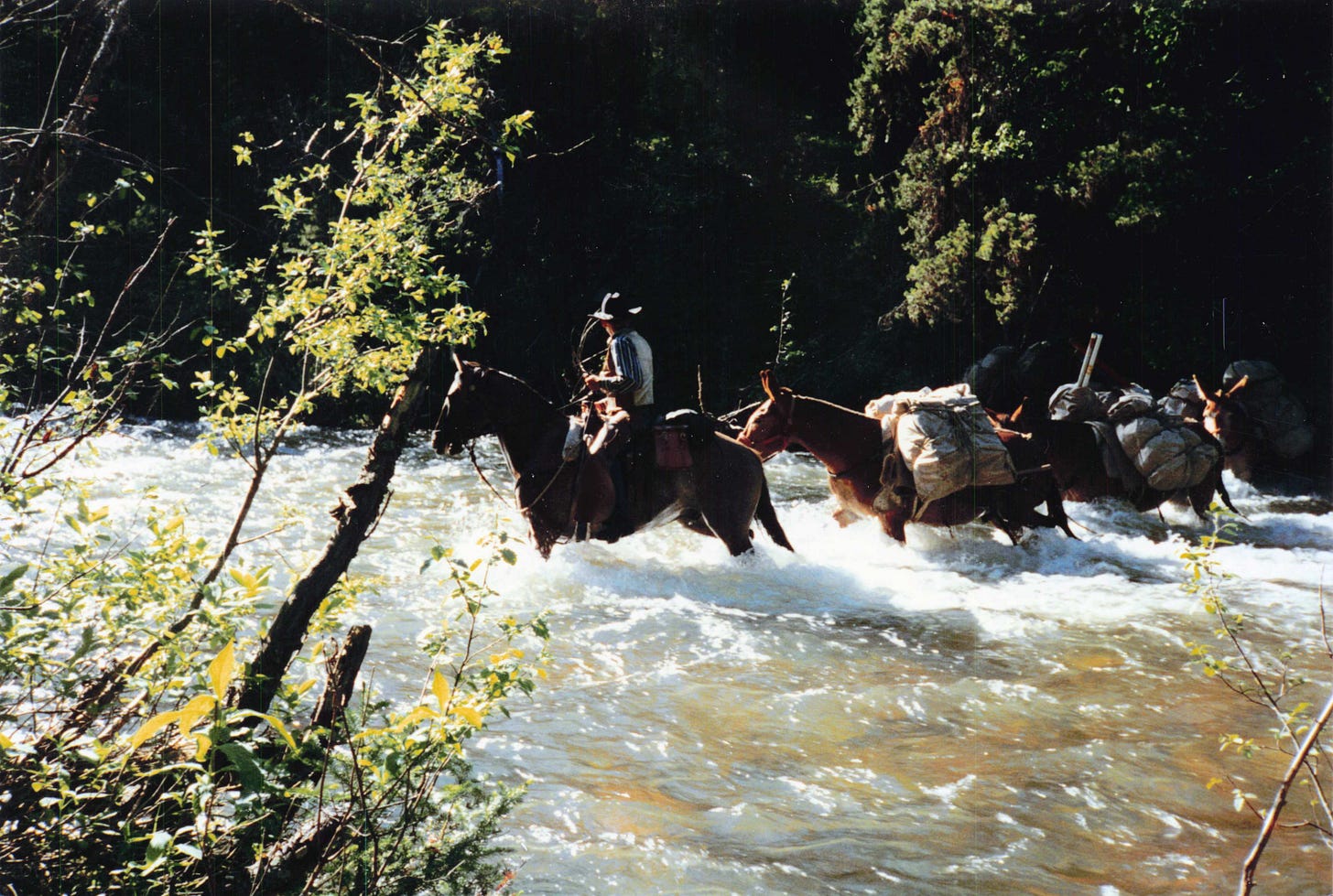Some horses really like to swim, especially on hot summer days. Mules do too. Yesterday, Smoke told me a story about a short mule that picked up all four legs each time the string crossed a deep river in the Bob Marshall Wilderness. His loads kept him afloat like water wings, and he gently floated, guided safely to shore by the mules in front and behind him. Growing up in Germany, I once took care of a white horse who would jump into any body of water, much like my kids do now, in a run. Like us, horses and mules seek shade on hot summer days. They drink lots of water, lick salt, and fight flies.
Since the fateful night of June 25, 1988, most of the Bob Marshall Wilderness has been burned by wildfire at least once, or even twice, and sometimes three times, and shade is precious. It had been an unusually dry spring in the mountains that year. The trails were thick with dust, most of the snow had melted, and the rivers were low. As usual, Smoke took a group of packing class students on his first trip of the year, up the North Fork of the Blackfoot River. Crossing the bridge at Smoke’s cabin, they followed the trail above the water. For the last time, thick lodgepole pines cast their shadows along the way. After a short stop at the North Fork Cabin, they continued up the Dry Fork, a seasonally flowing river, then almost dry. Shortly after, they made camp in a stand of old douglas fir. The horses and mules, happy to roll in the dusty sand, soon found the shade. As dark clouds were building in the west, Smoke tied down the tents in the meadow. After dinner everyone huddled under the rain fly, watching the wind pick up and the first lightning strike light up the hills. Soon, a small pillar of smoke rose up from the trees. The lightning had found a target, ready to burn. Followed by a good rain, the group decided to wait until morning to put out the fire.

To this day, Smoke’s outfitting permit notes that he is required to report and put out any fire he sees in the Bob Marshall Wilderness, and as a former wildland firefighter, he had done so many times. Every wildfire starts small. Often, he just filled his hat with water to pour on the small flames and finished it off with a shovel, an axe and dirt in a few minutes. So, the next morning after they packed up camp, the group hiked up the hill. A downed log was smoldering, some twigs blackened. In a few minutes, the log was rolled downhill and covered with sand. The crew was almost done digging a line around the area to prevent the hot ashes from creeping into the underbrush when a U.S. Forest Service employee walked up and told them to stop immediately. “This one,” the woman said. “We might let burn.” Worried about losing his outfitting permit if they did nothing, Smoke asked to radio the Seeley Lake Ranger Station. “Yes,” the ranger confirmed. “Take your bunch of wannabe firefighters and leave. This one we will watch to see what it does.”

The Canyon Creek Fire smoldered for another few weeks, clearing out the thick underbrush that had built up since the U.S. Forest Service started putting out any wildfire they could see. During the Great Depression, a huge infrastructure of fire lookouts, cabins, telephone lines, and even airfields was built in the Bob Marshall Wilderness with a single purpose: to detect and extinguish any forest fires. Any traditional burning practices used by the Salish and Pend d'Oreille to clear brush, maintain trails, encourage berry and meadow growth for horses and wildlife, or for beauty had long been restricted. By the time Smoke started his outfitting business in 1964, he was used to the dense trees and bushes that had grown thick and dark. Hardly believing what he heard, Smoke packed up his crew but made sure this decision to pull him off the fire was noted in his file.
On the next trip to the area two weeks later, Smoke noticed that the fire had grown but not by much. Then the wind picked up. Within a few days, the fire “blew up,” ultimately consuming 260,000 acres and almost reaching the basketball hoops in Augusta, MT until a September storm put it out. Smoke was visible as far east as Glendive, MT and ashes fell on Great Falls. It was the fastest fire in the Western United States to date. As the wind whipped the fire first west, then east, it chased Smoke across the Bob Marshall Wilderness. Before the time of fancy satellite communication, the U.S. Forest Service notified Smoke of the fire’s path and evacuations by throwing toilet paper rolls with notes out of airplanes. A day before the fire reached Augusta, MT it chased Smoke, Thelma, their guests, horses, mules, and wranglers out the Benchmark road. A U.S. Forest Service pump truck constantly wetted the trucks and trailers as the flames heated their windshields and windows.
The Canyon Creek Fire almost put Smoke out of business. All trips had to be canceled for the season, and he laid off most of his crew. Instead of showing his guests the mountains, he drove firefighting equipment to the fireline. Outfitting in the Bob Marshall Wilderness had never been the same since. Today, no trip is planned without at least two escape routes in case fire cuts off one trail. Fires are still reported, but none are put out unless the U.S. Forest Service decides to send in smokejumpers. The wilderness has become a laboratory for wildfires, their behavior, burn patterns, and amazing regenerative powers.
When I recently took a group of University of Montana students into the Bob Marshall (video by Tim Devine above), we could see just that. A whole bunch of burned lodgepole pines (from the 2017 Rice Ridge Fire) that once provided shade on a hot summer day, and even more new ones, an entire kindergarten of young trees sprouting from the ground. Where the fire had burned more than once, the meadows were lush and green and spotted with a myriad of wildflowers. The horses and elk loved the grass, and it was beautiful.
Listen to Smoke tell the story of the Canyon Creek Fire here:
I am off to Germany visiting family and friends until mid-August. Watch your inbox for a transatlantic edition of the Hush of the Land newsletter (if I find the time that is).
Stay cool and auf bald,
Eva
NEWS and upcoming EVENTS
Get in touch to pick up a “Hush of the Land” sticker at Smoke’s barn and help us spread the word about “Hush of the Land” by writing a review (Amazon) here or (Goodreads) here.
EVENTS
Lincoln, MT, July 27, Blackfoot Pathways Sculpture in the Wild Summer event series, 4-6pm, books for sale on site by Cassiopeia Books
NEW: Bozeman, Saturday, September 14 @2pm, Country Bookshelf
Bozeman, October 12, TBA
Seeley Lake, MT, December 6, Community Foundation Bldg, 2pm, hosted by Alpine Artisans
Virtual HUSH OF THE LAND Storytelling & Reading with book signing!
We are currently working on offering a virtual HUSH OF THE LAND Storytelling & Reading with book signing event. Please get in touch (info@evamaggi.com) if you would be interested in having us talk to your community or join your book club via zoom!
You can also find HUSH OF THE LAND on Facebook and Instagram.





